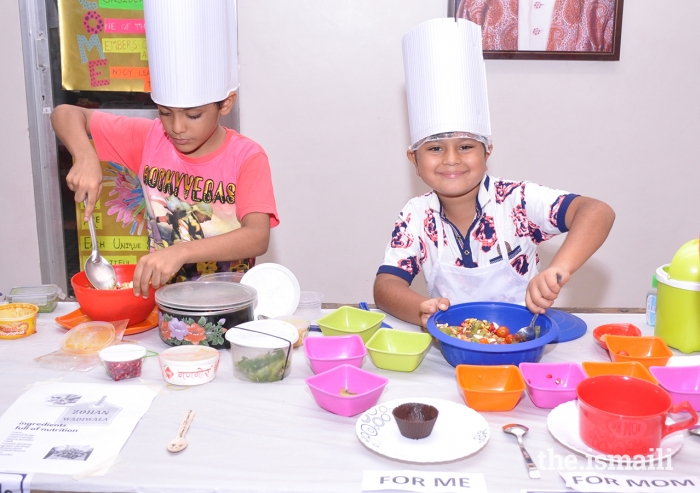World Diabetes Day is observed every year on 14 November to raise awareness of diabetes.
Type 2 diabetes is at least five times more common in South Asians than in the wider population. While there is currently no cure for it, people with diabetes can still live a full life by carefully managing their condition.
If you are affected by diabetes, it's important to avoid swings in your blood glucose (sugar), so it doesn't go too high or too low. What you eat and how often you eat has a direct impact on your blood glucose.
Also, people with diabetes are more prone to developing heart disease, but that doesn't mean you need to switch to eating boiled curries and Western foods. If you look after your diet and lifestyle habits, then you can significantly reduce your risks.
Eat regular meals. Eating regularly helps to keep your blood glucose levels steady throughout the day. It can also help you to maintain good energy levels as the day progresses. Get in the habit of creating a balanced plate.
Choose starchy carbohydrate foods, especially those which have a low glycaemic index (GI). Eating medium or low GI foods at mealtimes can help you manage your diabetes. Examples include dhals, beans, basmati rice, pasta, grainy or seeded breads (such as granary), bulgur wheat, sweet potato, cassava (mogo) porridge, and fruit and vegetables. Starchy foods will fill you up, often provide fibre, and tend to be lower in calories than fatty foods, but you also need to watch portion sizes.
We probably eat too much of the wrong type of carbohydrate. There's no need to have rice, chapati and potato in the same meal. And frying mogo is not a good idea! Instead, try boiling it and sprinkling with chilli and lemon.
Cut down on fried and fatty foods such as butter, ghee, full-fat cheese (like paneer), fatty meats, skin on chicken, chevda, ganthia, sev, samosas, crisps and pastries. Animal or saturated fat (from fatty meat and full-fat dairy products) can raise your bad (LDL) cholesterol level, and lead to a build-up of fatty streaks in your arteries, which can in turn reduce blood flow to your heart. Instead, choose monounsaturated fats, like the fat found in olive and rapeseed oil, avocado, nuts, or polyunsaturated fats such as corn oil, sunflower oil, and spreads made from these oils.
Of course this isn't a licence to smother your salad in olive oil or deep fry your kebabs in rapeseed oil! It is still important not to eat too much of these healthier fats, as weight for weight, they contain the same calories as unhealthy fats. Find out more about healthy cooking.
Eat more fruit and vegetables. These foods are rich in valuable antioxidants which can help prevent damage to your arteries. Enjoy a variety of colours so you get a good range of nutrients. For example, beta-carotene comes from orange and yellow coloured vegetables like carrots and yellow peppers, and anthocyanins (a powerful anti-oxidant) are found in purple plums, red cabbage and beetroot.
South Asian cuisine is packed with brightly coloured vegetables, from bhindi to brinjal, so enjoy at your leisure. Try the healthy okra recipe.
Enjoy fish and choose oily fish once a week. Scientific studies suggest that regularly eating oily fish can protect you from developing heart problems. The special omega-3 oils found in oily fish have been shown to lower a type of fat in your blood called triglyceride. They may also help to reduce blood stickiness, making your blood less likely to clot and cause a blockage in your arteries. Examples of oily fish include salmon, fresh tuna, mackerel, trout, sardines and herring.
Swap high sugar foods for low sugar foods. Cut back on tinned fruit in syrup, sugar, and mithai, and consider tinned fruit in natural juice, artificial sweeteners, and dried fruit instead. Be especially careful with sugary drinks, since they tend to get into your blood stream more quickly. Choose unsweetened fruit juice and have it with a meal so you slow down the rise in your blood glucose (because the juice mixes with other foods in your gut). Or choose diet drinks and use an artificial sweetener for hot drinks.
Note that many sugary foods tend to also be high in fat (think of cakes, biscuits, kheer, kulfi) and are generally unhealthy, so it's best to save them for special occasions.
Choose foods which are low in salt. We don't usually measure salt in traditional cooking – it's often a generous pouring straight from the salt container, and we don't think twice about it. However, there is now solid research showing that eating too much salt makes you more at risk of raised blood pressure and strokes. As you try out some of the healthier recipes on this site, you'll notice that they are low in salt yet high in flavour. It is possible to eat healthily and still enjoy traditional foods.
Get down to a healthy weight and stay there. Just by losing 5 – 10 per cent of your weight can make a significant difference to your blood pressure, blood fats and blood glucose control. Adopt a healthier lifestyle by choosing balanced meals and being more active.










